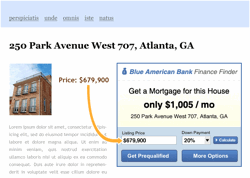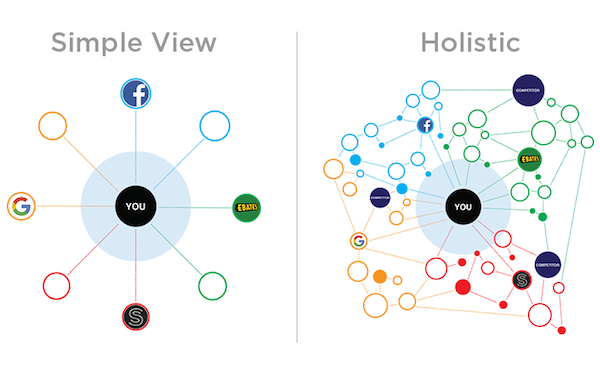What is "semantic advertising"? (Or, advertising encounters of a semantic kind.)
The short answer: advertising that uses semantic web technology, of course. But as it turns out, that definition is highly dependent on how you define "advertising" and "semantic web".
With a flurry of innovation happening in both these areas — and their intersection — there are now several different meanings for semantic advertising, depending on who you ask.
Here are 4 distinct kinds of semantic advertising:
#1: Contextual advertising with semantics
Several ad networks — Google's AdSense being the most popular by far — automatically analyze the content of web pages to dynamically determine which ads are the most relevant to serve there. If I'm on a site reading about LCD televisions, they show me ads for retailers who sell them — without the publisher or the advertiser (or even the ad network) having to explicitly specify anything. This is really just contextual advertising, but when it uses semantic technology to determine the context, it's called semantic advertising.
This is probably the most common interpretation of semantic advertising today.
Ad networks such as Peer39 and adpepper's iSense have really emphasized their use of semantic technology as a competitive advantage under this banner of semantic advertising. For the most part, their semantic technology consists of proprietary algorithms for natural language processing. It doesn't have anything to do with the Semantic Web as Tim Berners-Lee would describe it, although an argument could be made that it does implement a top-down semantic web approach.
[Update: in response to this post, Ian Saunders, one of the co-inventors of iSense, posted an excellent comment below with a more detailed explanation of their approach.]
Now, if site publishers were to add semantic data to their sites via a bottom-up approach of RDF tags and/or microformats — which will happen once the business incentives for doing so are compelling enough — then that metadata could be used to increase the accuracy of contextual ads even more. This would have the benefit (and some potential trouble) that publishers could give semantic ad networks hints about the semantic meaning of content on a page, leveraging true semantic web standards.
#2: Semantic search advertising
A new generation of semantic search engines such as Powerset and Hakia are trying to leverage semantic technology to provide people with a better search experience. This seems to be gaining traction, particularly in vertical search, where the meaning of words and relationships can be disambiguated relatively easily — for example, the job search site Trovix.
Of course, the business model for these semantic search engines almost certainly ends up being advertising. And if you advertise on a semantic search engine, that's semantic advertising, right?
Maybe. The interesting twist is that advertisers in semantic search may ultimately end up bidding on concepts and relationships rather than keywords or phrases. Now that is actually a pretty cool concept of semantic advertising.
#3: Dynamic advertising content
One of the goals of the Semantic Web proper is to facilitate programmatic exchange of data across the Internet. By making the web more "machine readable" — above and beyond the human readable content of the web we love today — it can foster a new era of smart, connected software applications.
Jonathan Mendez of RAMP Digital has applied this concept to dynamically feeding content into interactive Flash ads, and he has called them semantic ads. The idea is that an advertiser — particularly a retailer — can expose their latest offerings and inventory as XML semantic data, and then the creative person or agency who makes an interactive ad can read this data behind the scenes to dynamically change the content of the ad accordingly.
This is an advertising-specific incarnation of a tried-and-true principle in web development: the separation of presentation and data. As advertisements become more data-rich, this makes the job of maintaining them more manageable.
Someone in the advertiser's IT department takes responsibility for publishing the latest data. Someone in the marketing/creative team takes responsibility for displaying that data in the coolest way possible. Once both parties agree on the format of the data, it requires relatively little coordination for updates to happen on either side.
This could be even more powerful if the format of the semantic data for these ads were standardized across multiple advertisers, perhaps even across multiple industries. That way, a marketer could create awesome data-rich ads without ever having to explicitly coordinate with a company's IT department. This could also enable groovy "mashup ads" that leverage data from multiple sources — say a retailer and the various manufacturers' brands it sells.
Dapper's MashupAds platform is one possible incarnation of this with a more standardized approach. There's a good article on ReadWriteWeb about their strategy to have advertising drive the adoption of the semantic web.
#4: Advertising inside semantic data
When I wrote my article on semantic marketing earlier this year, my vision of semantic advertising was the paid placement of data into authoritative sources of semantic data:
Perhaps this will lead to a new type of semantic advertising? People paying to have their semantic data distributed through certain networks, tagged with certain metadata under the authority of the network owner. I believe there are vast entrepreneurial opportunities for vertical market networks here.
This is an entirely new channel of advertising, and as such, it's hard to picture in the abstract. So here are a couple of examples.
Yahoo! recently released SearchMonkey, which enables search engine results to have more context-specific structure. For instance, a restaurant result from Yelp might contain ratings, address and phone number, a thumbnail, links directly to user reviews, etc. This more structured information is provided by Yelp to Yahoo! as semantic web data.
In this scenario, Yelp has become a powerful authority of semantic data on restaurants. The semantic data they expose to Yahoo! ends up having a significant impact on how users get their first impression of a restaurant in the search results.
So what if Yelp charged restaurants to include additional data elements in these listings? For instance, imagine an optional "web coupon" link that could appear in these search results if the restaurant paid for it. This would help the restaurant stand out even more, and hopefully compel searchers to act on the opportunity for a special offer.
Now Yelp may or may not want to do exactly this, and Yahoo! may or may not allow it, but this illustrates a new kind of semantic advertising. The coupon information is actually machine-readable semantic data being published by Yelp — that Yahoo! is then eventually displaying to end-users. But other sites might also take advantage of Yelp's semantic data, further propagating the value of that embedded coupon.
For another example, consider Thomson Reuters' OpenCalais project. OpenCalais is an application that takes plain HTML pages — such as a blog page — and generates semantic web metadata for the named entities (e.g., people, companies, geographies), facts, and events that it identifies.
Semantic advertising in this context would be permitting advertisers to include sponsored metadata in these results. So, for instance, if a semantic reference to a company was going to be included in the metadata results generated by OpenCalais, that company could pay OpenCalais to include additional metadata. Or, more intriguingly, advertisers could bid to associate additional metadata with other facts or events — consider how sporting events would be a great opportunity for someone like Nike to provide semantic references to licensed merchandise.
Again, Thomson Reuters may or may not choose to do this. But it's certainly conceivable that they could. And there's no doubt that other semantic data authorities will.
In many ways, I believe this type of advertising is the most accurate definition of "semantic advertising", since the advertising itself is semantic data embedded inside streams of semantic data.
But all 4 of these types of semantic advertising will be fascinating to watch as they evolve.





Scott-
This is a great and useful summary. Thanks for including us.
Shoot me in an email if you’ll be in NYC for Advertising Week.
Jonathan
Nicely done Scott. I love how you broke out current and projected uses of semantics in a content-ad connected world.
Any good entrepreneur can see an opening in the way ads are placed now basically using keywords only. Not to mention the laughable results we have all experienced. Do a search on “Ferry Disaster” and see the ads for a Cruise next to pictures of upside-down passenger ferries.
Wouldn’t want to pay for that ad. More importantly wouldn’t want to generate the negative association of my cruise company as being insensitive.
Expert System has been an important semantics engine for the last 15 years. In fact our technology uses the same 4 methods of human comprehension to achieve a better than 85% precision out of the box. So we agree with your 4th method as the most accurate, useful and flexible. And today we are announcing just that. Here is our release – http://www.marketwire.com/press-release/Expert-System-899771.html
Brooke Aker
Expert System CEO USA
baker@expertsystem.net
Scott,
The potential of what the semantic web offers advertisers for the future seems to only be limited by imagination (and funding).
You’ve done a great job here of putting into perspective the here and now as well.
Roll on the day when all sites have useful data that helps precise ad targeting.
Hi Scott,
As one of the co-inventors behind iSense, perhaps I just correct a slight inaccuracy in your otherwise great commentary.
iSense is far removed from the emerging natural language, algorithmic based semantic classification systems. Our technique is based upon a considerable amount of effort in creating an enormous taxonomy based system, essentially built by hand. A team of some 40 linguists and lexicographers, under the guidance of my colleague and eminent linguist, Dr David Crystal, spent some 4 years, assigning words from a dictionary to a framework of knowledge categories. This has to be kept up to date, of course, as new words and meanings are continually entering the language. At the core of the system is a point well covered in the design of the Semantic Web, that of polysemy or alternative sense of words. it’s difficult – which is why simple statistical algorithms (such as looking for high-frequency keywords) don’t work. We addressed the polysemy issue directly by working through the dictionary and identifying all the polysemous items (which meant most of the content words – average number of senses was 2.4), assigning them to knowledge categories. Synonyms were routinely covered in the same way, as were graphic variants – even more important in e-commerce, where, for example, a system accepts ‘cellphone’ but not ‘cell phone’.
Our approach is not to identify better keywords on a page but to analyse and understand all the words on a page. Only in doing so, can we gain a true picture of the various content themes on a page, with most webpages being multi thematic. This enables a better classification but also a correct identification of the various senses of words being used on a page. This last factor is a fundamental weakness of the current contextual offerings with daily examples of ad misplacements based upon an alternative meaning of a keyword.
Ad misplacement is an issue in its own right with the horrendous examples of ad placements alongside potentially controversial and brand damaging content. Our semantic solution includes a brand protection layer enabling ads to be blocked from appearing against content such as Adult, Nudity, Gambling, Filesharing, Racial and Religious Bigotry, Bad language and 12 major categories. Again, only effective using semantics.
In summary, the only way that effective analysis can be achieved is through a non algorithmic method- language is simply too complex. It may have been hard work but it has been done, the patents obtained, and now we are uniquely placed to offer iSense, a true Semantics based advertising solution.
Ian,
Thank you for posting a more detailed explanation of the iSense approach! It’s fascinating to read about, and it gives some great insight into how your product is delivering better results.
No doubt, the polysemy problem is one of the biggest hurdles in providing an accurate “semantic layer” to existing web content. The two key points you mention about your approach — (1) an extensive and human-powered taxonomy and (2) whole-page analysis, not just keyword analysis — both sound like good strategies to me.
That being said, unless I’m still missing something (and please tell me if I am!), it is still an “algorithmic” approach in the sense that the actual run-time placement of ads on pages is done automatically, by analyzing the language on a page — with your patented techniques, referencing your hand-built taxonomy — and then serving up ads based on that calculation. A very sophisticated algorithm, true, but still an automated process at the end, no?
And although your approach addresses some of the conceptual ideas of the Semantic Web (e.g., polysemy resolution), it’s still not “Semantic Web” in the technical sense of working with explicit RDF metadata?
Of course, there really isn’t much RDF metadata out there in the wild to work with. But I am curious to see if at the some point the incentives tip — and how folks such as yourself would be able to leverage that to further enhance your solution.
Again, thanks for the great feedback. Good luck with iSense!
can you give me a suggestion for doing this topic as a research?
Thank you, Scott, very informative.
The good news is that semantic technologies are finally emerging into advertising industry.
The bad news is it’s still unclear how all the semantic targeting processes are carried out. I have never seen how these solutions actually work. There’s really skimpy info on the web about the results or benefits of these semantic advertising technologies. How much do they improve ad relevancy or increase publishers’ or ad networks’ revenue?
Theoretically, it’s clear the way these technology should be working, but a good demo, or some statistics would throw a light upon the true advantages of semantic targeting. How can a publisher make sure that switching from contextual (keyword targeting) to semantic advertising with this very solution will bring in more relevant ads, more traffic and more revenue?
To the best of my knowledge, Peer 39 and iSense are pioneers in semantic advertising and they have been here for a while, although I’ve spotted some newbies too as I searched for semantic targeting providers. Hopefully, some of them will eventually come up with more illustrative information on this whole thing of semantic advertising.
Thanks, Nicole.
I agree with you that the details and effectiveness of semantic advertising solutions are still somewhat murky. This is partly because they are new, partly because they are rapidly evolving, partly because it’s still a niche space, and partly because of competitive secrecy. However, all those factors will eventually change as semantic advertising becomes more stable and established in the broader market.
One step in that direction may be the creation of a “semantic advertising corpus”, a collection of trial-run pages that can be used to compare how well different semantic advertising platforms discern the true meaning of pages with ambiguous keywords. This would enable an apples-to-apples comparison, albeit with the caveat that performance in the corpus is not necessarily equivalent to performance in the wild. But with a really good corpus, such a test should be pretty close to reality.
I suppose the corpus would have to change on a regular basis, so that semantic advertising companies couldn’t game the system by building to the test. But imagine a once-per-quarter release of the corpus, where the tests are run fresh on the first day. Then, for the next quarter, new pages are included in the corpus. Archive them all for trends and for training sets for future semantic developers to leverage.
Perhaps a researcher in this field would be interested in tackling this?
Thanks Scott for your response.
I agree that these are quite explanatory factors for the obscurity in the operations of semantic technologies. It’s natural that companies won’t be opening up all the secrets of their technology that has taken them years to be developed. And I do agree that the realization of the “semantic advertising corpus” can be a promising kickoff for a new competitive stage for semantic advertising providers. It will also be a good push for them to make their technologies better and better.
Also,thanks for your new post with your ideas and suggestions on the matter.
I’m doing a research for my term paper on advertising technologies. Overall, I could find sufficient information on different targeting technologies, but I’ll resonate the previous opinions that there’s lack of facts and stats! Only after surfing the net for a while did I run into a semantic technology company ,as I googled for semantic targeting, which actually has a demo version of their semantic targeting solution on their website. So one can actually try it out and see how it works and view the results of analysis…which I did but as the displayed results were that of semantic analysis, I’ll abstain from telling if they were accurate or no, as I’m too bad at analyzing a sentence and grammar is certainly not my thing. Although I’d figure it out, if I got a bit deeper… anyways, other people would certainly be able to evaluate it more accurately than me.
Forgot to say, in case anyone wants to check it out and make evaluations, here’s the link: http://www.4adnetworks.com
Just one question!
Behavioral targeting includes semantic adverising, does it?
Great article! real time feedback in a Semantic Age that will be customer-centric will be mind-blowing too!
Another great posting that I found. Thanks for share….I will coming back later…